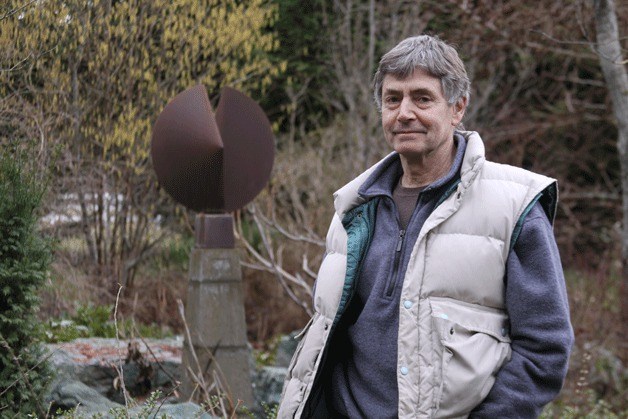There’s a certain beauty to the forms and straight lines that make up Richard Nash’s home on North Whidbey.
Concrete was used to create angular paths, walls and water gardens that are lined by hardy native bushes, grasses and bamboo.
The paths lead you around a corner to open space and an expansive view of Skagit Bay.
It seems clear that Nash, who once studied art in Japan, brought back some of that Asian influence when he and his wife Sherry designed their contemporary-style home in 2002 then built it themselves over four years.
And, from studying the composition of the house and its surroundings, it also is evident that the abstract artist in Nash was at work.
“I’m not sure which influenced what,” Nash said as he stood from his backyard and looked back at his long rectangular house with large glass panes. “My dad is a retired architect. That didn’t hurt. My wife is excellent at design. Between the three of us, we did pretty good.”
It might not be art, but Nash’s house is one of his more magnificent creations on Whidbey Island.
The Oak Harbor abstract artist, who is featured in a new book, “100 Artists of the Northwest,” is known regionwide for his craft, however, on Whidbey, his sculptures are only found at private residences.
That will be changing soon.
One of Nash’s metal sculptures is pegged for public display in Oak Harbor this spring. The work is a tribute to four former Oak Harbor educators. Wallie Funk, the former publisher of the Whidbey News-Times, purchased the sculpture and donated it to the City of Oak Harbor.
Nash has sculptures on display to the public on Camano Island and in La Conner, Sheridan, Ore., and McMinnville, Ore.
His paintings are featured in art galleries in three states, including Penn Cove Gallery in Coupeville.
He’s been able to devote all of his time to art now after completing his home and retiring from teaching after 30 years as an art instructor at secondary schools in the Oak Harbor School District.
Although he retired in 2002, the teaching hasn’t stopped.
“As a retired educator, it’s been really important for me to help people understand abstract art,” Nash said. ”I’m non-representational. It means there are non-recognizable things in it. I work with just shapes, forms and lines.”
His metal sculptures are made of corten steel and can stand 10 feet tall and weigh a half ton. Several of his large sculptures and some of his acrylic paintings are located at Matzke Fine Art Gallery and Sculpture Park on Camano Island.
Karla Matzke is the owner of the unique 3,000-square foot gallery and 10-acre park. She co-authored the book “100 Artists of the Northwest” with E. Ashley Rooney.
The Matzke gallery and sculpture park will feature several of the book’s featured artists’ works from March 1-April 13. Twenty-five of the artists are expected to be on hand for the opening party, book signing and potluck from 4-9 p.m. March 1.
Nash is the only Whidbey Island artist featured in the book. She said she was asked by Rooney which artists she would recommend for the book.
Nash was an obvious choice for her.
“I’m very proud of the artists I show here,” Matzke said. “The artists here are not hobbyists. They’re all professionals.”
Nash said he loved his career as a teacher in Oak Harbor and is lucky to be able to devote himself full-time to art now.
He’s involved in several projects and is surprised how much time is involved in marketing compared to painting and sculpting.
Nash has been instrumental in spearheading a fundraising effort to bring art to Oak Harbor High School. Two sculptures by Bow-Edison artist Ries Niemi are pegged to be installed by late summer.
Another project Nash is been involved with has stalled.
The Oak Harbor City Council in December of 2010 approved an effort to honor three of Oak Harbor’s founders with a downtown waterfront sculpture by Nash, but fundraising and questions about the art work’s location has impeded progress, Nash said.
The idea of having one of his sculptures displayed in the town he’s called home for 42 years holds special meaning to Nash. And he’s looking forward to the work dedicated to the teachers being installed this spring.
“Definitely,” he said. “It’s very nice to have my art being a part of the community scene.”
He’ll continue to educate about abstract art.
“Most people like nostalgia,” he said. “That’s what most people tend to buy. The abstract art to me is more poetic. It’s a nice way of working with shapes, forms and lines and creating something visually attractive. It should endure. If it’s a good piece, you shouldn’t get tired of looking at it.”


